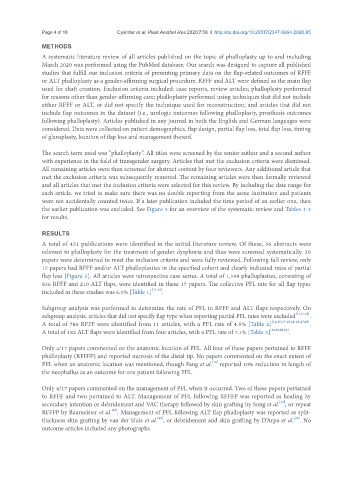Page 670 - Read Online
P. 670
Page 4 of 18 Cylinder et al. Plast Aesthet Res 2020;7:58 I http://dx.doi.org/10.20517/2347-9264.2020.85
METHODS
A systematic literature review of all articles published on the topic of phalloplasty up to and including
March 2020 was performed using the PubMed database. Our search was designed to capture all published
studies that fulfill our inclusion criteria of presenting primary data on the flap-related outcomes of RFFF
or ALT phalloplasty as a gender-affirming surgical procedure. RFFF and ALT were defined as the main flap
used for shaft creation. Exclusion criteria included: case reports, review articles; phalloplasty performed
for reasons other than gender-affirming care; phalloplasty performed using techniques that did not include
either RFFF or ALT, or did not specify the technique used for reconstruction; and articles that did not
include flap outcomes in the dataset (i.e., urologic outcomes following phalloplasty, prosthesis outcomes
following phalloplasty). Articles published in any journal in both the English and German languages were
considered. Data were collected on patient demographics, flap design, partial flap loss, total flap loss, timing
of glansplasty, location of flap loss and management thereof.
The search term used was “phalloplasty”. All titles were screened by the senior author and a second author
with experience in the field of transgender surgery. Articles that met the exclusion criteria were dismissed.
All remaining articles were then screened for abstract content by four reviewers. Any additional article that
met the exclusion criteria was subsequently removed. The remaining articles were then formally reviewed
and all articles that met the inclusion criteria were selected for this review. By including the date range for
each article, we tried to make sure there was no double reporting from the same institution and patients
were not accidentally counted twice. If a later publication included the time period of an earlier one, then
the earlier publication was excluded. See Figure 3 for an overview of the systematic review and Tables 1-3
for results.
RESULTS
A total of 421 publications were identified in the initial literature review. Of these, 56 abstracts were
relevant to phalloplasty for the treatment of gender dysphoria and thus were screened systematically. 29
papers were determined to meet the inclusion criteria and were fully reviewed. Following full review, only
17 papers had RFFF and/or ALT phalloplasties in the specified cohort and clearly indicated rates of partial
flap loss [Figure 3]. All articles were retrospective case series. A total of 1,199 phalloplasties, consisting of
836 RFFF and 210 ALT flaps, were identified in these 17 papers. The collective PFL rate for all flap types
included in these studies was 6.1% [Table 1] [13-29] .
Subgroup analysis was performed to determine the rate of PFL in RFFF and ALT flaps respectively. On
subgroup analysis, articles that did not specify flap type when reporting partial PFL rates were excluded [13,21,26] .
A total of 780 RFFF were identified from 11 articles, with a PFL rate of 4.5% [Table 2] [14,15,17-19,22-25,27,29] .
A total of 182 ALT flaps were identified from four articles, with a PFL rate of 7.1% [Table 3] [14,16,20,28] .
Only 4/17 papers commented on the anatomic location of PFL. All four of these papers pertained to RFFF
phalloplasty (RFFFP) and reported necrosis of the distal tip. No papers commented on the exact extent of
[18]
PFL when an anatomic location was mentioned, though Fang et al. reported 10% reduction in length of
the neophallus as an outcome for one patient following PFL.
Only 4/17 papers commented on the management of PFL when it occurred. Two of these papers pertained
to RFFF and two pertained to ALT. Management of PFL following RFFFP was reported as healing by
[27]
secondary intention or debridement and VAC therapy followed by skin grafting by Song et al. , or repeat
[15]
RFFFP by Baumeister et al. . Management of PFL following ALT flap phalloplasty was reported as split-
[28]
[16]
thickness skin grafting by van der Sluis et al. , or debridement and skin grafting by D’Arpa et al. . No
outcome articles included any photographs.

